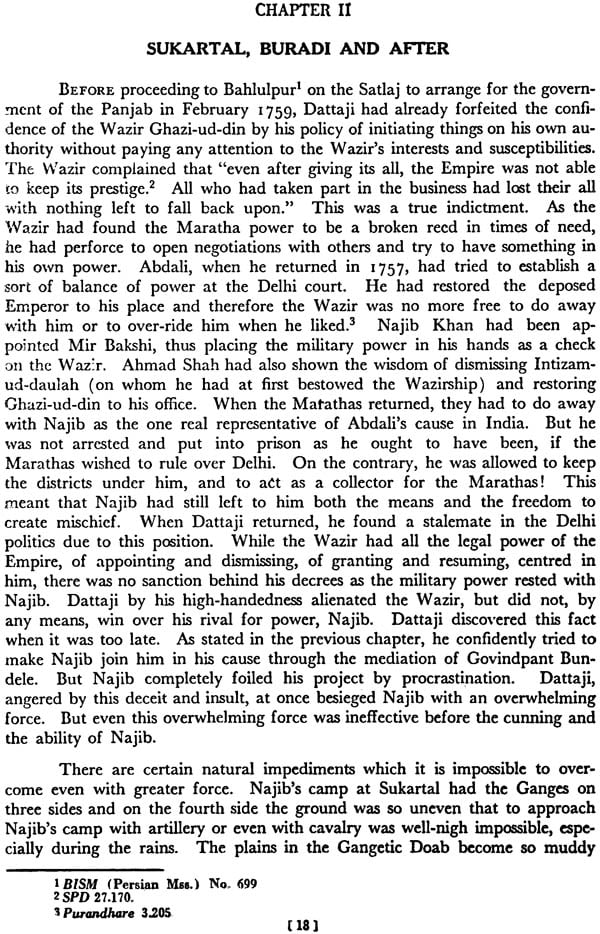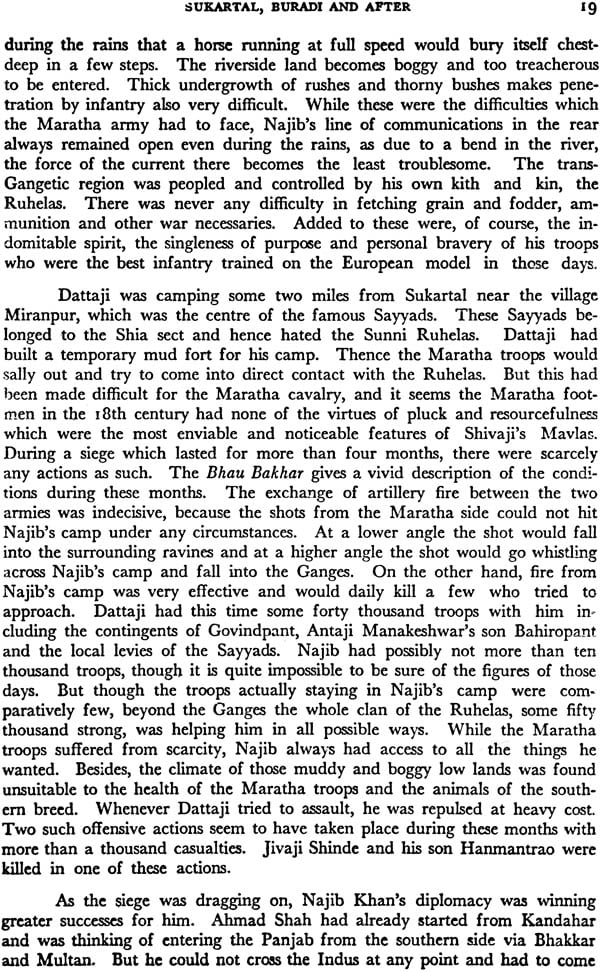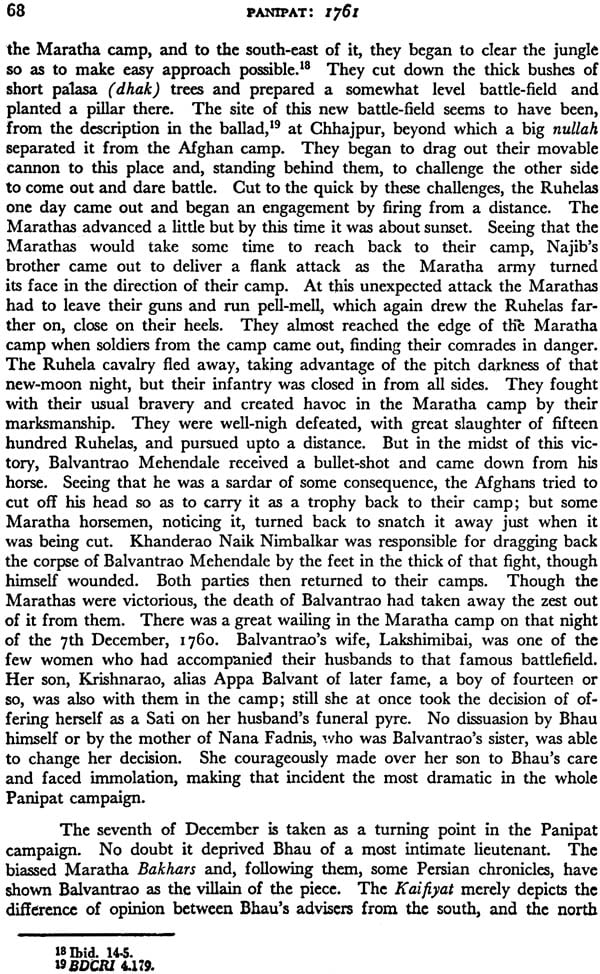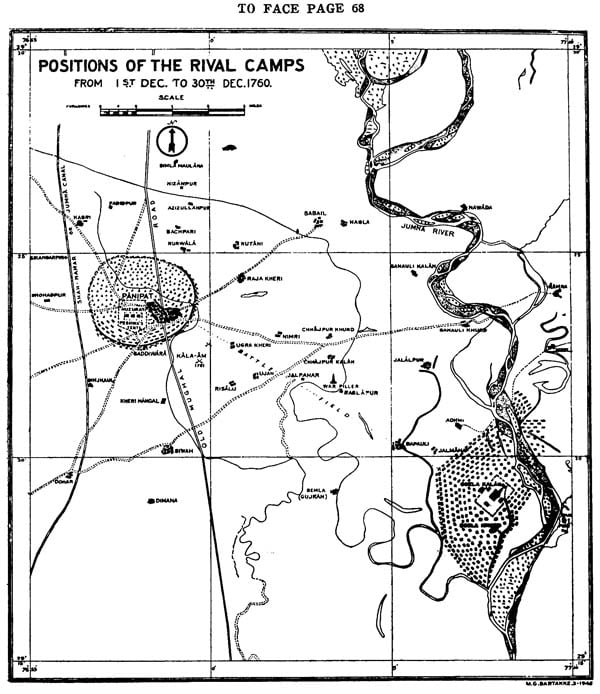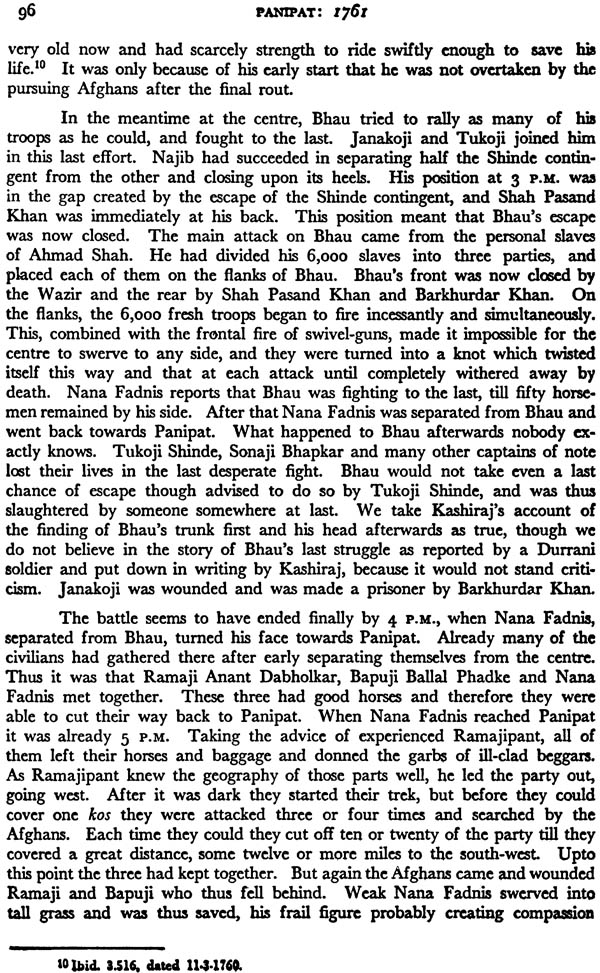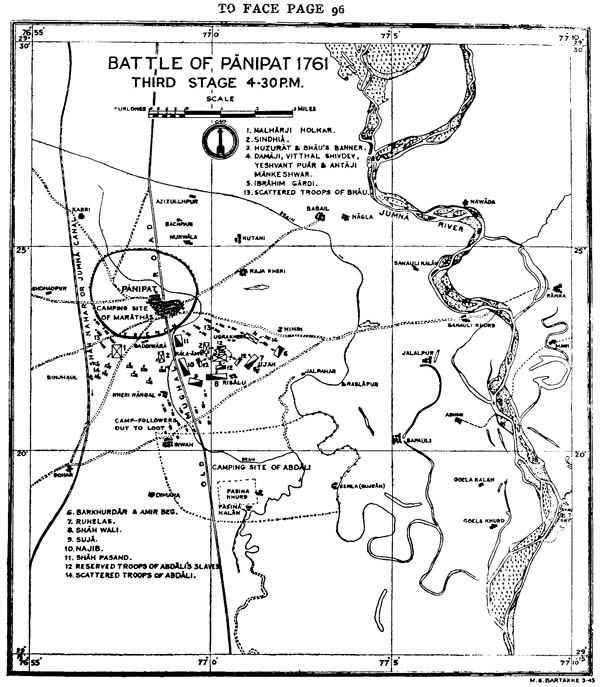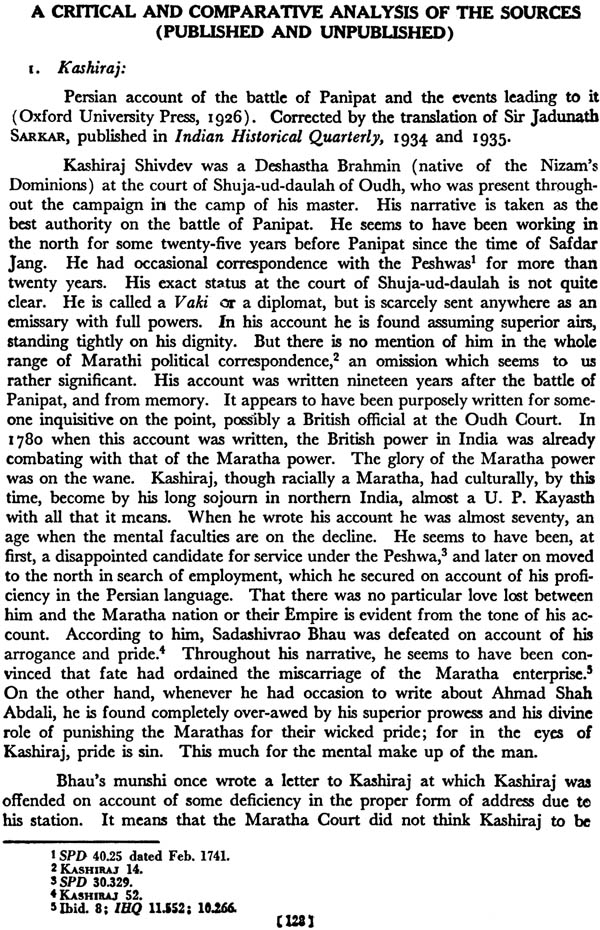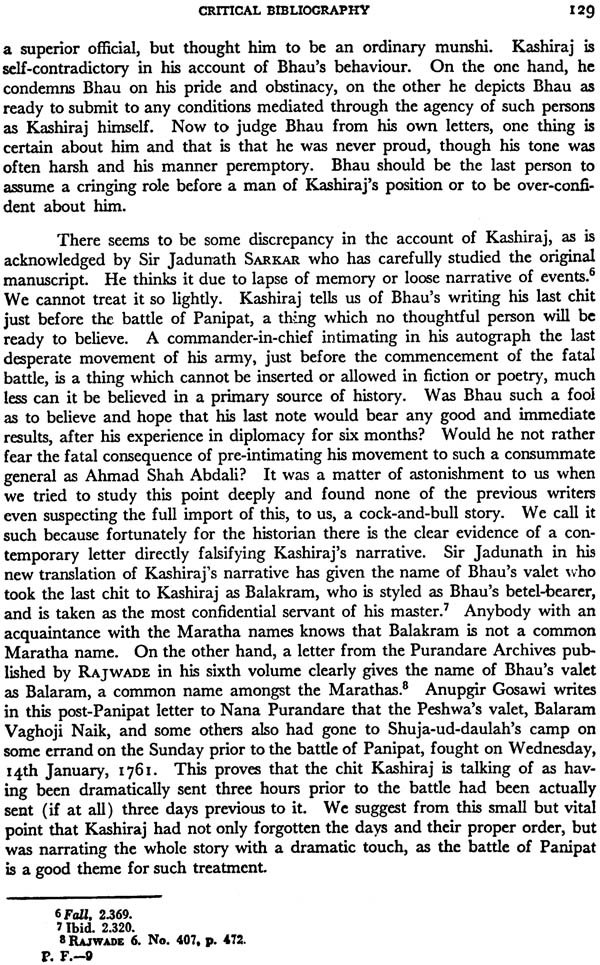
Panipat: 1761
Book Specification
| Item Code: | NAM123 |
| Author: | Tryambak Shankar Shejwalkar |
| Publisher: | Deccan College Postgraduate and Research Institute |
| Language: | English |
| Edition: | 1992 |
| Pages: | 185 (9 B/W Maps) |
| Cover: | Paperback |
| Other Details | 9.5 inch x 7.0 inch |
| Weight | 360 gm |
Book Description
Let me explain the scope purpose of this monograph and my design in writing it.
As the subject is an old one, generally known to most students of Indian history, I have thought of curtailing the narrative within minimum limits, leaving the bare anatomical structure behind. To fix the attention of readers on facts, I have avoided over-burdening this fragment of history with detail. Having no particular taste for the pageantry of history, I have eschewed all description with hyperboles surcharged with chauvinistic sentiments and thus left an opets, dramatists and novelists.
Though so designed, the book is written for both the student and the general reader. As such it has assumed the form of a narrative and an essay combined. The appeal is to the reason, and to the sentiment, nevertheless.
The work has entailed a reconstruction on the basis of the revaluation of the old material with the help of new material filling in the gaps, and a closer study of the positive background of geography. The result is a proper visualisation of the scene leading, in its turn, to a correct interpretation of the various sources and a restatement of the whole problem.
The battle of Panipat has naturally occupied a prominent place in the heart of the historically minded Marathas. Their interest in the affair was heightened by the genius of Vishvanath Kashinath Rajwade, the founder of a school of historical research in Maharashtra. It has become a perennial theme for discussion ever since. Rajwade was not noted for a sound judgment, however. His writings have provoked more polemical literature than any other man’s in Marathi, and even Sir Jadunath Sarkar, writing in English, could not resist the temptation of having a fling at him.
This brings me naturally to the point when I should state the purpose of writing this volume. Had a person of Sir Jadunath Sarkar’s competence and calibre, with all facilities at his command, dealt fairly with the subject, there would have been no valid ground for any one to dip pen in ink. He has devoted two hundred pages to the history treated in the present volume, in his Fall of the Mughal Empire, Vol. II. But all the shortcomings for which he had been criticised before by Maratha scholars are found repeated in this work. He has treated the subject from a wrong angle as a part of the history of the Mughal Empire. He has overlooked important relevant material. His interpretation of the material used is incorrect, not to say inadequate. He betrays insufficient knowledge of the Marathi language and inexpertness in using the material in that language. An unsympathetic critic must, at least, be fully and correctly acquainted with the subject he writes upon, and these conditions are unfortunately not found fulfilled by Sir Jadunath’s Very brilliant presentation in masterly English. The result is the reader is carried away by the presentation, viewing things in a wrong perspective, unconscious of the errors committed or the incorrectness of the conclusions deduced. Sir Jadunath does not seem to believe in sticking to one ethical standard when treating the various parties in a struggle. It is true that nothing succeeds like success and the Marathas have failed in history. But historians, when passing judgment, should not forget the standard of conduct followed by the various parties in history. Ahmad Shah Abdali’s strict discipline should not make us forget the methods of achieving it, nor should his victories efface the Afghan atrocities leading to that end. The Marathas could not establish their rule on a sound basis, and the foreign British succeeded where the indigenous Marathas failed. But this should not make us blind to the fact of Clive’s forgery and cheating or the Bengal famine of 1770, carrying away more than a third of the Bengal population, a direct result of that rule. (It is curious to note in this connection that Cambridge History of India, Vol. V, does not even mention this famine, a significant indeed) The Marathas had the ambition of ruling over India, no doubt, they were not prepared to forsake their standard of conduct to gain this end.
Instead of merely criticising others’ works in detail ultimately leading to nothing, I thought it better to write out the whole piece myself in my own manner. The difference of opinion will be found, I hope, justified in the performance. In the world of Indian scholarship at present, the vogue of copying, imitating and adapting is current. This results in circulating the error in a wider area which later on comes to be called a universally accepted fact. Many scholar throughout the length and breadth of India are now-a-days trying to utilise the Marsthi material and weaving it into the thread of their histories. An aggressive occupation of the historical field is going on before our eyes. But the danger underlying these efforts is scarcely understood by the scholarly knights-engaged in these adventures. It is high time some one should put a stop to their activities, for while it is easy to disseminate an error, it is not so easy to recall it back or to stop its ravages. As an humble effort in the cause of weeding out errors, I place this book before the public.
Though this monograph is complete in itself, it is not intended to supplant other works in the same field. This book is to be treated as an adjunct to the general histories of the period, without knowing which this work may not be properly understood or appreciated. As I have written my work with an eye on Sir Jadunath’s volume, it has unconsciously assumed the form of a reply to his writing. In fact, where I have not differed from him I have almost followed him, especially in the portion mainly dependent on Persian chronicles studied from the MSS by him only. I believe there can be no higher tribute to a man’s original work than of following him.
Most of the ordinary readers will miss the graphic part of history they have up till now read in the accounts of Panipat. I thought of omitting them from my narrative because I have no belief in their truth of even probability. The idea of copying such details from the chronicles simply because no other light can be shed on these events or episodes, I think as faulty. By their repetition, a disservice is done to the cause of history. National sentiment is sure to be perturbed by this line of action, no doubt, but it is better to take that risk than to be an agent in circulating palpable falsehoods. Those who have a liking for such stuff can have recourse to the original chronicles which should go as literary pieces, but not as history. They can be turned to sociological uses too.
The study of this subject I began a becade ago and many causes have retarded its progress. I had an intention of first stating the theory of the Maratha State in an independent monograph and then of writing this volume for the correct understanding of which it is absolutely necessart. Now I am stating the same in bare outline in the Introduction. Then again for various reasons, mainly but not exclusively personal, the work was written in parts and then held over. This fact has adversely affected its merit as a literary product. Had the work been written out in the first glamour of the subject and in the Panipat locality, it would definitely have been a more unitary piece of work. But the loss on the presentation side has been made up by gain on the thinking side. The battle could not have been satisfactorily described by me four years ago, when I could not visualise it properly. After that, the coming in of new material and even the hope of getting access to valuable material held over my design. Such rare material has been made available to me by the kindness of co- workers in the field of history, especially through the assiduity of Mr. G.H. Khare of the Bharat Itihas Samshodhak Mandal. The thanks of all students of history would naturally go to him, in addition to these of mine. Other scholars who have helped me in furthering my project are Dr. G. S. Ghurye of the University School of Sociology in Bombay; Rao Bahadur K.N. Director-General of Archaeology, who acted as a host to me in my northern tour; the authorities of the B.I.S. Mandal, Poona; and many others too numerous to be individually mentioned. The readers’ thanks should also go to Dr. S. M. Katre, Director of our Institute, for the drive he has shown in pushing the work through and for its general and artistic get-up, and to the Press for their excellent workmanship.
Shivaji founded the Maratha State for doing good to the Maratha people. But he was also conscious of his role in Indian history as a defender of the Hindus against the onslaught of Islam. At the same time he was no crusader against Islam as alien faith; he only wished to divest it of its political role in India. In the first part of his life, he was not sure of his line of action or final goal. He made up his mind finally after his return from Agra in 1666. The establishment of an independent Hindu State as a rallying point for all Hindus became his thereafter. Compromise with Muslims or service under an Islamic State he found incapable of rousing the Hindus from their age-long stupor. These would neither defend Hinduism from their age-long stupor. These would neither defend Hinduism in the long run, nor allow the Hindus to grow to their full stature. Only a direct challenge to the Islamic idea of State-that Islam only is to live and grow while others must wither away and die-was the surest way of defending Hinduism and the Hindus. Aurangzib wished to unite India under one sceptre, that of Islam under the Mughals. Shivaji girded his loins to establish an independent Hindu sovereignty in India free the shackles of the Mughal octopus. He succeeded in his determination and crowned himself as the Chhatrapati in 1674. He forged new weapons to gain his ends at the cost of his enemies. While his subjects were well protected, he made the enemy subjects pay for his wars against their state by the imposition of the Chauth, to escape which the only remedy was to come under his rule. Aurangzib revived the Jizya in the Mughal dominions after a lapse of a hundred years, to propagate Islam and weaken the infidels. Shivaji hurled back the missile with the aim of meeting the new menace by his demand for Chauth from the enemy lands. Aurangzib pulled down the temples and desecrated the Hindu shrines. Shivaji replied by reviving the temples turned into mosques by the Muslims in the south. While Aurangzib’s manner was aggressive and bigoted, Shivaji’s was defensive and moderate. This distinction should be borne in mind when judging Shivaji and Aurangzib, a distinction which marks the modernity and secularism of the one and the medievalism cum ecclesiasticism of the other. Not understanding this difference, This difference, Toynbee in his Study of History (3.203) has classed Shivaji with Ivan the Terrible, Saladin and Suleyman the Magnificent as champions of alien (non-western) civilizations. Shiivaji was not only a champion of old-world Hinduism, but its modernising reformer also. He not only endowed temples or patronized Hindu learning; he also (and primarily) built new forts on the sea-coast for protecting his newly- established navy on the European model, and sent his own ships to Arabia for direct trade. He would not turn his new state into a closed, hermit kingdom, after the manner of Japan in the sixteenth century, but left it open to all foreign influences in all walks of life, after due regulation to guard his independence. Had Shivaji’s ideas been properly understood and followed by his successors, there would have been no occasion for a Panipat in 1761.
Shivaji was a bold soldier and a clever general, an able engineer who knew the art of fortifications better than the engineers who knew the art of fortifications better than the engineers themselves, and, above all, had studied geography with the minutest detail with the help of specially prepared charts, as Abbe Carre, the French padre, reports. Can any one doubt Shivaji’s modernism with this testimony? Shivaji not only revered Brahmins, but employed them in building his with the whip of a taskmaster, too. He made them crow him as a true twice-born warrior and received back into his own caste man like Nataji Palkar, who had been living in Afghanistan as a full Muslim for ten years. His bold stand electrified the whole Hindu society from the Indus to the Brahmaputra. Sikhs, Rajputs, Jats, Bundelas, and even the distant Ahoms of Assam rose against Aurangzib and made his reign one long line of more or less successful rebellions. In the south, Shivaji built up a strong state guarded by long lines of impregnable forts and newly-built ships, which withstood Aurangzib for a quarter of a century, and ultimately sent him to his grave in 1707.
With all their personal drawbacks and vices, Shivaji’s immediate successors could tide over the Fundy tide of Mughal invasion because the men trained under Shivaji knew the basis of his state. With the passing away of these men, a new twist was given to the basis of the Maratha Sate which ultimately led to Panipat. It came to pass in the following manner. Shivaji’s grandson Shahu had been captured with his mother by Zulfiqar Khan when he took Raigad in 1689. He lived in Aurangzib’s moving camp for full seventeen years till 1707, when he was released on the advice of Zulfiqar khan with the intention of creating dissentions amongst the Marathas. He had been befriended by Aurangzib and his daughter in his captivity, as a result of which Shahu imbibed a life-long sense of personal gratitude towards the Mughal imperial house. He could never entertain the idea of completely destroying the Mughal empire. On the other hand, he now and then gave a helping hand to the Mughals. As the orphan son of Shivaji’s eldest son who had suffered death terribly at the hands of Aurangzib, and himself a long sufferer in captivity through all sorts of insults, privations and slavery, the Marathas naturally felt a sympathy for Shahu when the returned. But the army and the civil officers all divided into two opposing factions, creating a permanent schism in the Maratha polity, which is historically found perpetuated in the establishment of Kolhapur as a separate state.
Shahu triumphed over his aunt Tarabai, because he was the legitimate heir for whom common people felt a sympathay born of his miseries as well as on account of the shrewish behaviour of his overbearing aunt, who turned all her officers into enmity, one after the other. Shahu returned as a nominee of the Mughals, and as such received the support of all Muslim officers as well as all those who sided with the Mughals for personal gain. All opportunists and new candidates, who had nothing to hope from the party of Tarabai, naturally supported Shahu. Ambitious and unscrupulous men found a new opening for their talents in this fratricidal war. But his supporters overlooked one important constitutional point in their enthusiasm for the good new king. He had returned with the Mughal badge of slavery round his neck. The lands bestowed on him by the Mughal emperor are styled Zamindari lands. His so-called kingdom can at most be styled an autonomous feudatory principality in the language of constitutions. And what was worse, he had accepted this status not as a policy to tide over the times, but in all sincerity which he meant to keep. His gentleman’s attitude sealed the fate of the Maratha State.
Most of the men who had gone over to Shahu’s side had gone with selfish motives of personal aggrandisement. They hoped to remain strong and almost free to do what they liked under a weak master such as Shahu was, on account of his precarious position between two mill-stones. The man who helped Shahu most in building up his party and stabilising his rule automatically became his Prime Minister or Peshwa. This was Balaji Vishwanath, comparatively a new man from Konkan and a careerist bent on utilising all opportunities to strengthen himself and his master, without regard to the distant effects of his steps on the Maratha polity. Shahu did not know Shivaji’s ideals and ideas, ways and ideas, ways and means, because he had spent his boyhood and youth in the Mughal camp. Balaji would not know, because that would not have furthered him in his rise. Shahu wanted a new class of persons to keep his poise in the face of overbearing, old officials. Balaji, coming from an outside caste, looked down upon by the entrenched ministers (Deccan Brahmins), wanted a needy master who would go out of the groove to dothe needful. Besides, Balaji was endowed with all the personal qualities necessary for imposing oneself on persons of various denominations and motives. Being an outsider, he could pose as a third (disinterested) party in all tussles and quarrels, and would be accepted as such by others also. His positions, in course of time, became unassailable.
Balaji’s opportunism is seen in his support to the Sayyid brothers, the king-makers. He invited their help for crushing Damaji Thorat in his internal rebellion against Shahu’s rule, while he accompanied them to Delhi in order to facilitate their intrigues against the lawful emperor. In return he received fresh orders under the seals of puppet emperors, bestowing the Maratha kingdom on Shahu, and the release of Shahu’s mother from captivity at Delhi. Thus Shahu’s collapsing rule was propped up with Mughal support! In addition, Shahu accepted the duty of serving the Mughal State with fifteen thousand troops, which were to be placed at the disposal of the Mughal viceroy in the Deccan to buttress his administration, one-fourth revenue (Chauth) of the south being his wages for the same. Shahu was thus not only to be a creature of the Mughals, but was to guarantee the continuation of their rule in the Deccan!
This was really cutting the roots of the Maratha State envisaged by Shivaji and reared carefully by his successors. Shivaji had envisaged the gradual withering away of the tree of Islam in India-though not necessarily through the agency of the Marathas-and planned his Maratha State for aiding the attainment of that end. The Marathas were expected to be the spearhead of the charge against Islam no doubt, but other Hindus were also expected to act their part in the grand achievement. The end was not a Maratha empire spreading all over India, but the complete freedom of Hindus. If other provinces in India gained their freedom by their own exertions, so far so good. But the Marathas would not sit idle if there was no stir amongst them. They would do the work themselves, irrespective of the cost.
| Introduction | ||
| I | The Marathas in the Panjab and Beyond | 1 |
| II | Sukartal, Buradi and After | 18 |
| III | Sadashivrao's Appointment for Northern India | 31 |
| IV | Kunjpura | 52 |
| V | Panipat | 62 |
| VI | The Battle | 86 |
| VII | The Judgment | 106 |
| Critical Bibliography | 128 | |
| List of Maps | ||
| 1 | India-Mughal Subahs | 6 |
| 2 | Panipat Route March | 36 |
| 3 | Panipat Vicinity at Present | 62 |
| 4 | Positions of the Rival Camps I | 65 |
| 5 | Positions of the Rival Camps II | 68 |
| 6 | Positions of the Rival Camps III | 72 |
| 7 | Battle of Panipat-First Stage | 87 |
| 8 | Battle of Panipat-Second Stage | 90 |
| 9 | Battle of Panipat-Third Stage | 96 |
